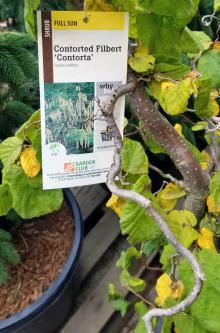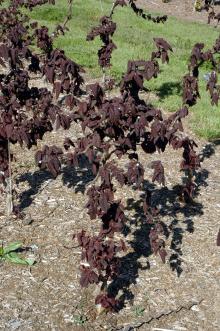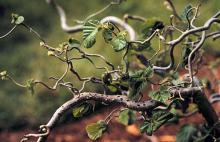See:
Hazelnut (Corylus avellana) - Eastern Filbert Blight
Cause Anisogramma anomala, a fungus that has infected both hazelnut orchards and home gardens throughout the Pacific Northwest. The fungus has a life cycle of 2 or more years including a 12- to 15-month latent period when no symptoms are visible. In spring, spores are forcibly ejected and released in a sticky, white ooze in wet weather. Wind-driven rain and splashing droplets spread spores to young, developing shoots. Infection occurs in wet weather from bud break through shoot elongation. Stroma begin to develop the second summer after infection and mature by late fall. Several hours of continuous rain are needed for ascospore release. Stroma will continue to sporulate, even after the diseased branch has been removed from the tree, until the canker dries out completely. Cankers on large limbs, trunks or resistant cultivars may not produce stroma. New stroma develop each year as the canker continues to expand along and around the branch. Numerous new infections also occur each succeeding year.
The ornamental cultivars Burgundy Lace and Red Dragon have the single dominant-resistance gene from Gasaway. A new mutation allowing the fungus to reproduce on cultivars with the Gasaway gene was detected in 2023. Strains of Anisogramma anomala from eastern North America can also overcome the single dominant-resistance gene bred into new cultivars. There are restrictions in Oregon on commercial and ornamental hazelnut cultivars imported from out-of-state (OAR 603-052-0825).
Symptoms Infected branches may die suddenly from July to September. Dead leaves may stay on the branch. Elongated, raised bumps begin to form on infected twigs and branches in June. When the bark is removed, the cambium below the bumps is chocolate-brown. Bumps continue to expand until the fungus breaks through the outer bark in July and August. A white, oval to football-shape fungal structure called a stroma can be seen then. As the stroma matures from August to October, it turns black and raises about 0.12 inch above the branch. Stromata are in relatively straight rows lengthwise along the branch. Cankers enlarge along the branch each year. Branches die back when expanding cankers girdle branches and limbs.
Cultural control An integrated approach using several cultural and chemical techniques is needed for adequate disease control.
- Plant resistant cultivars.
- Thoroughly inspect new plantings for 2 years to find trees that may have been infected prior to purchase.
- Remove and destroy infected branches at least 1 ft below cankered area before bud break in spring.
Chemical control A total of four (4) applications is recommended to adequately protect trees. Apply starting at budswell to bud break and continue at 2-week intervals to cover an 8-week period. Thorough coverage of all branches is essential. Alternate or tank-mix fungicides from different groups with different modes of action. The addition of a surfactant, if allowed by the label, will improve disease control.
- Avelyo at 4 to 5 fl oz/100 gal water. Group 3 fungicide. 12-hr reentry.
- Bonide Fung-onil Multi Purpose Fungicide at 3.5 teaspoons/4 gal water. Group M5 fungicide. H
- Broadform at 7.6 fl oz/A can be used in nurseries and landscapes. Do not use with EC or oil-based products. Excellent control. Group 7 + 11 fungicide. 12-hr reentry.
- Copper products result in good control. Group M1 fungicide. O
- Badge SC at 7 to 20 pt/A. Oregon and Washington only. 48-hr reentry. O
- ChampION ++ at 7 to 10.5 lb/A Group M1 fungicide. 48-hr reentry. O
- Cuprofix Ultra 40 Disperss at 10 to 15 lb/A. Oregon and Washington only. 48-hr reentry.
- Grotto at 152 gal/A. Oregon and Washington only. 4-hr reentry. O
- Kocide 50 DF at 4 lb/A plus 1 pint superior-type oil/100 gal water. 48-hr reentry. O
- Monterey Liqui-Cop at 1 to 2 Tbsp/gal water. H
- Nu-Cop 50DF at 8 to 12 lb/A with 1 pint superior-type oil/100 gal water. 48-hr reentry.
- Hi-Yield Vegetable, Flower, Fruit and Ornamental Fungicide at 9 teaspoons/4 gal water. Group M5 fungicide. H
- Herritage at 6.4 oz/A. Use as a protectant only on a 10-day schedule. Do not use with silicone-based surfactants. Sprayers should not be used on apples. Moderate control. Group 11 fungicide. 4-hr reentry.
- Insignia SC at 6 to 12 fl oz/100 gal water. Do not use with organosilicate-based adjuvants. Group 11 fungicide. 12-hr reentry.
- Tourney EZ at 1 to 4 oz/100 gal water. Group 3 fungicide. 12-hr reentry.
Notes OxiDate is registered but it will not control this disease due to its short residual activity. Previsto is registered but resulted in poor control.
Pageant is not recommended since only the Group 11 chemistry in this prepackaged mix is effective. The other chemical was ineffective in field tests. The effective Group 11 chemistry is available alone as Insignia and is recommended to use.
Biological control
- Serenade Garden Disease Control Concentrate at 2 to 4 fl oz/gal water. Variable efficacy in western Oregon. H O
Reference Mehlenbacher, S. A., and Smith, D. C., 2009. 'Red Dragon' Ornamental Hazelnut. HortScience 44:843-844.




